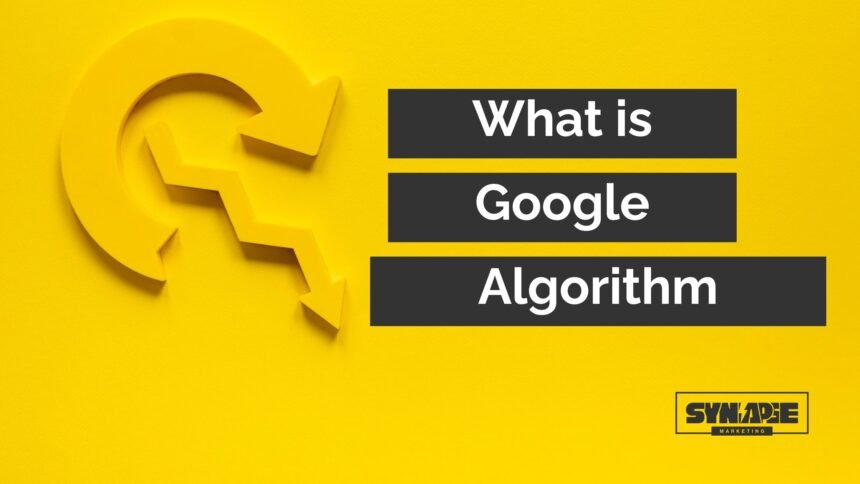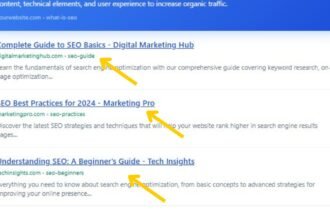Let’s face it, Google runs the internet. Or at least, it runs how people find things on the internet. Whether you’re searching for the best local coffee shop, a breakdown of quantum physics, or ironically, “What Is Google Algorithm?”, the answer you see at the top of Google’s search results didn’t get there by chance.
It got there because of Google’s Algorithm, the invisible force behind the scenes that decides who ranks, who disappears, and who dominates the first page.
As someone who works daily with SEO, search engine algorithms, and ranking factors, I can tell you this: If you care about where your website shows up on Google, you need to understand what this algorithm is, how it works, and why it keeps changing.
Why? Because the Google Algorithm doesn’t just impact SEO nerds and marketers anymore. It shapes how we consume information, what businesses succeed online, and how users engage with the web whether they realize it or not.
In this publication, I’ll break it all down for you:
- What Is Google Algorithm? (It’s more complex than you think)
- How it works behind the scenes to rank pages in search results
- The ranking factors it cares about most right now (User intent rules)
- Why it keeps evolving—and how to stay ahead of every update
By the end, you won’t just understand what the Google Algorithm is.
You’ll understand how to work with it, not against it.
What Is Google Algorithm?
So, what is Google Algorithm, really? Strip away the technicalities and complex engineering, and here’s the simplest way to think about it:
Google Algorithm is a set of complex, evolving rules that determines which content shows up when you search for something.
Every time you type a query—whether it’s “best SEO tools” or “how to bake banana bread”—Google’s algorithm goes to work behind the scenes. Its job is to sift through billions of web pages in microseconds and show you the ones it believes are the most relevant, helpful, and trustworthy.
But here’s the kicker: There’s not just one Google Algorithm.
Instead, Google uses a network of algorithms, systems, and AI tools working together in real-time. They evaluate everything from the content on a page, the quality of backlinks, site authority, user behavior, to your location, device, and even your previous search history.
Think of It Like This:
Imagine Google as the world’s busiest and smartest librarian. When you ask it a question, it races through an enormous library (aka Google’s index) to pull out the best answers. But this librarian isn’t guessing. It’s applying years of experience, thousands of signals, and evolving logic to figure out what you really want—even if you don’t say it clearly.
That’s the magic of Google Algorithm:
It balances content relevance, user intent, and authority to deliver the best answers at lightning speed.
What Factors Does It Consider?
To answer “What Is Google Algorithm?” properly, you need to know the factors it weighs. While Google famously guards its full formula like the Crown Jewels, SEO experts and official sources agree it looks at things like:
- Keywords: Are the right search terms present, naturally and contextually?
- Backlinks: Does the site have credible links from other trusted sources?
- Content Quality: Is the content original, valuable, in-depth, and aligned with user needs?
- User Experience: Is the site mobile-friendly, fast, and easy to navigate?
- Contextual Relevance: Does this page align with your search intent, location, and device?
These factors aren’t static. Google updates its algorithm thousands of times per year, often tweaking how much weight is given to each element based on new tech, search trends, and spam-fighting efforts.
If you’re wondering why some sites stay on top of Google while others vanish overnight, the answer almost always lies in how well they align with these evolving rules.
How Does Google Algorithm Work? Behind the Scenes of Search
Now that you understand what Google Algorithm is, let’s unpack how it works in practice.
Because contrary to popular belief, it’s not magic. It’s a systematic, data-driven process—refined by decades of machine learning, AI, and user behavior analysis.
Here’s the simplified breakdown of what happens every single time you hit ‘search’:
Step 1: Crawling the Web
Google’s journey starts with Googlebot, its army of web crawlers. These bots roam the internet 24/7, following links from page to page, collecting new URLs, and updating old ones. Think of them as digital explorers mapping every corner of the web.
They use sitemaps, internal links, and backlinks to discover new pages. If your site isn’t being crawled properly? You’re not even in the game.
Step 2: Indexing Pages
Once crawled, your website’s content doesn’t automatically show up in search results. First, it goes into Google’s index—a vast, organized database storing trillions of web pages.
During indexing, Google analyzes your page for:
- Keywords (yes, still important)
- Content quality (original, useful, relevant)
- Contextual signals (topic, intent, authority)
- Site structure and hierarchy (technical SEO matters here)
If your page doesn’t meet certain quality or relevance standards? It might never make it into the index.
No index = no chance at ranking.
Step 3: Ranking Content
This is where the real magic of the Google Algorithm kicks in. When a user submits a query, Google’s systems quickly:
- Consult the index for potentially relevant pages.
- Apply hundreds of ranking factors (see: backlinks, keywords, content depth, site speed, mobile usability, E-E-A-T).
- Consider user intent, device, location, search history, and even freshness of content.
- Serve up results in a carefully prioritized order—what you see as Page 1.
All of this happens in a fraction of a second.
What Are These Ranking Factors, Really?
While Google keeps its exact recipe secret, SEO pros and Google’s own guidelines point to these big categories:
- Content Relevance: Does this answer the search query clearly and effectively?
- Authority: Is this website recognized as trustworthy within its industry (backlinks, brand signals)?
- User Experience (UX): Is the page fast, mobile-friendly, easy to navigate, secure?
- Search Intent Alignment: Is this content informational, transactional, navigational, or commercial—matching what the user really wants?
- Contextual Signals: Location, language, device, and personal preferences shape results.
All of this ties back to Google’s mission: organize the world’s information and make it universally accessible and useful.
Which is why the algorithm adapts constantly—to serve better answers, faster.
What Influences Google’s Algorithm?
If you’re still wondering, “What Is Google Algorithm?”, here’s the reality: it’s not just a single formula—it’s a sophisticated system fueled by hundreds of evolving ranking factors. Some of these factors carry more weight than others, but together, they determine which pages win visibility and which ones sink in the abyss of Page 10.
To succeed in Google’s search results, you need to understand the core elements the algorithm values most. Let’s break them down:
1. Content Quality (The Reign of E-E-A-T)
Forget keyword stuffing and shallow posts—quality content rules Google’s algorithm. In particular, Google rewards pages that demonstrate:
- Experience: Real, first-hand knowledge on the topic.
- Expertise: Clear authority in the subject matter.
- Authoritativeness: Backed by reputable sources, citations, and brand recognition.
- Trustworthiness: Transparent, secure, reliable information.
This framework is known as E-E-A-T (Experience, Expertise, Authoritativeness, Trustworthiness) and it’s central to how Google Algorithm evaluates content today.
What It Means for You:
Publish content that’s useful, original, well-researched, and created by credible sources. Thin, regurgitated posts simply don’t cut it anymore.
2. Backlinks & Site Authority (The Internet’s Voting System)
Backlinks—links from other websites to yours—remain one of the strongest signals of authority. If high-authority sites trust and reference your content, Google sees that as a vote of confidence.
But it’s not just about quantity. Quality, relevance, and trustworthiness of linking domains matter far more than sheer volume.
What It Means for You:
Focus on earning organic, editorial backlinks from respected websites in your niche. Avoid shady link schemes—they can do more harm than good.
3. User Experience Signals (SEO Beyond Content)
Google doesn’t just read your pages; it watches how users interact with them. Metrics like:
- Page speed (faster is better)
- Mobile-friendliness (non-negotiable in 2025)
- Navigation and site structure (easy to use, easy to understand)
- Security (HTTPS)
These technical elements heavily influence Google ranking. Why? Because a poor user experience often signals poor content quality.
What It Means for You:
Ensure your site loads fast, works flawlessly on mobile, and offers visitors a smooth, intuitive journey.
4. Relevance to Search Intent & Context (NLP in Action)
Google’s algorithm doesn’t just match keywords anymore—it understands context. Thanks to advancements in Natural Language Processing (NLP), Google can interpret the meaning behind search queries and connect users with content that fits their intent:
- Informational: Seeking answers (e.g., “how does Google algorithm work”)
- Navigational: Looking for a specific site (e.g., “Gmail login”)
- Transactional: Ready to buy (e.g., “buy running shoes online”)
- Commercial investigation: Comparing options (e.g., “best SEO tools 2025”)
What It Means for You:
Align every piece of content with the specific search intent it’s targeting. Use clear, helpful language, semantically related keywords, and answer user needs directly.
Key LSI & NLP Keywords to Include Naturally:
| Primary Term | Supporting LSI / NLP Terms |
| What is Google Algorithm | search engine algorithm, Google updates |
| SEO | ranking factors, Google ranking, backlinks |
| Search ranking | content relevance, user intent, site authority |
| Website optimization | mobile-friendly, page speed, E-E-A-T |
| Organic search | quality content, semantic search, SERP |
These aren’t just SEO buzzwords—they’re essential concepts Google’s algorithm actively looks for to understand and rank your content.
Why Google Keeps Updating Its Algorithm And Why You Should Care
If you’ve been in the SEO world for more than five minutes, you’ve probably heard the phrase:
“Google changed the algorithm again.”
And trust me—it’s not just industry gossip. Google updates its search algorithm thousands of times every year. Some updates are so small they barely make a ripple. Others, like Core Updates, can send shockwaves through entire industries, wiping out traffic for some sites while skyrocketing others.
But why does Google keep updating the algorithm so relentlessly?
Simple: To deliver better search results, faster, and with more accuracy.
Google’s ultimate mission hasn’t changed:
“To organize the world’s information and make it universally accessible and useful.”
— Google
What’s changed is how good Google has become at interpreting human intent, filtering out spam, and rewarding quality content over manipulative tactics.
Types of Google Algorithm Updates (And What They Aim to Fix)
Spam Updates:
Designed to penalize low-quality, manipulative sites (keyword stuffing, paid links, doorway pages).
Impact: Keeps spam out of your search results.
Content-Focused Core Updates:
Google re-evaluates what constitutes helpful, authoritative content. These updates often shift the SEO landscape dramatically.
Impact: Rewards websites that focus on E-E-A-T and genuine user value.
AI & Machine Learning Updates:
With tools like RankBrain, BERT, and MUM, Google gets better at understanding context, nuance, and natural language—improving how it interprets search intent.
Impact: Prioritizes pages that match what users actually mean—not just what they type.
Experience & UX Updates:
Things like Page Experience or Mobile-First Indexing push websites to improve speed, usability, mobile-friendliness, and security.
Impact: Better experience for users; better rankings for sites that prioritize UX.
Why These Updates Matter to You
If you’re creating content or managing a website, these updates aren’t just technical adjustments—they directly impact:
- Your visibility in search results
- Your organic traffic (up or down)
- Your ability to compete in your niche
Outdated SEO tactics like keyword stuffing, thin content, or manipulative link-building aren’t just ineffective—they’ll hurt your site.
Google Algorithm now prioritizes sites that create genuinely valuable, well-researched, and user-focused content.
In fact, a 2024 study from SEMrush found that sites aligning with user intent and E-E-A-T principles were 78% more likely to maintain stable rankings post-update (Download Semrush Report Here).
How to Stay Ahead of Google’s Algorithm Updates
- Focus on the fundamentals: Quality content, technical SEO, UX, and trustworthy backlinks.
- Stay informed: Follow trusted SEO resources (Search Engine Land, Moz, Ahrefs, Google Search Central).
- Adapt quickly: Audit your site regularly for outdated practices.
- Think long-term: Optimize for people, not algorithms.
How User Intent Shapes the Google Algorithm: The Real Secret to Rankings
If you want to truly grasp What Is Google Algorithm?, you need to understand this one truth:
User intent is everything.
Over the years, Google has evolved from matching mere keywords to understanding the why behind every search. That’s thanks to advances in Natural Language Processing (NLP), AI, and machine learning systems like RankBrain, BERT, and MUM. These technologies help Google interpret not just words, but meaning, context, and intention.
When you type something into Google, you’re not just submitting data—you’re expressing a goal. The Google Algorithm is designed to figure out what that goal is and deliver the content that best satisfies it.
The 4 Main Types of Search Intent Google Prioritizes
Understanding these categories is key to optimizing your content for the algorithm and the human behind the screen.
Informational Intent
The user wants to learn something.
Examples:
- What is Google Algorithm?
- How does SEO work?
- What are the benefits of backlinks?
Best content: In-depth guides, how-tos, FAQs, educational blogs.
Navigational Intent
The user is looking for a specific website or brand.
Examples:
- Gmail login
- Ahrefs blog
- Google Search Central
Best content: Strong brand presence, optimized for branded terms.
Transactional Intent
The user is ready to take action or make a purchase.
Examples:
- Buy SEO tools online
- Best web hosting deals
- Sign up for Semrush trial
Best content: Landing pages, product pages, comparison pages, clear CTAs.
Commercial Investigation Intent
The user is comparing options before making a decision.
Examples:
- Best SEO software 2025
- Top keyword research tools
- SEMrush vs Ahrefs
Best content: Comparison posts, case studies, pros & cons breakdowns, detailed reviews.
Why This Matters for Your Rankings
Google’s algorithm weighs user intent heavily when deciding which content deserves the top spot.
If your blog post, landing page, or website doesn’t align with the searcher’s goal, it doesn’t matter how optimized your keywords are—you won’t rank.
For example:
Someone searching “What Is Google Algorithm?” isn’t looking to buy SEO software. They want a clear, authoritative explanation.
That’s why this guide focuses on education, not sales.
Optimizing for Intent (The Winning SEO Strategy)
- Use precise keywords, but write for the human question behind them.
- Structure content to match the reader’s journey—answer questions clearly.
- Incorporate related NLP/LSI terms to reinforce relevance (search ranking, website optimization, user experience, etc.).
- Make your page’s purpose clear—whether it’s to inform, sell, or guide.
When your content aligns with both the algorithm and the user’s true goal, your rankings improve—and your traffic sticks.
Why Understanding Google Algorithm Matters to You
At this point, you might be thinking:
“Okay, I get what Google Algorithm is. But why should I care if I’m not an SEO specialist?”
Fair question. But here’s the reality:
If you publish content, run a website, manage a business, or care about visibility online—understanding the Google Algorithm is non-negotiable.
Why? Because the algorithm determines:
- What people see
- What content wins traffic
- Which brands earn trust online
- How buying decisions are influenced
Whether you’re a blogger, startup founder, marketer, or small business owner, knowing how Google’s Algorithm works helps you make smarter decisions about content strategy, website structure, and digital marketing investments.
3 Reasons You Should Care (Even If You’re Not “Doing SEO”)
It Controls Who Sees Your Website
Organic search drives over 50% of all web traffic globally (BrightEdge, 2024). If you’re not optimizing for how Google ranks content, you’re missing out on the biggest traffic source available.
No visibility = no clicks = no conversions.
It Impacts How People Perceive Your Brand
People trust Google’s top results. If your brand appears on Page 1, it signals authority and relevance. If you’re buried on Page 5? Most users won’t find you—much less trust you.
Perception of authority is shaped by where Google puts you.
It Shapes Your Long-Term Growth
Search visibility compounds over time. The more your content aligns with Google’s evolving algorithm, the more consistent and scalable your organic traffic becomes.
This reduces reliance on paid ads and builds lasting digital assets.
Good SEO = long-term sustainability, not short-term hacks.
How to Future-Proof Your Content for Google’s Algorithm
- Prioritize Quality Over Quantity:
Stop chasing keyword density. Start creating content that genuinely helps your audience. - Optimize for Humans First, Google Second:
If your content satisfies user intent, Google will follow. - Stay Updated on Industry Changes:
SEO isn’t static. Keep learning, adapting, and refining your strategies. - Focus on Fundamentals (E-E-A-T, UX, Technical SEO):
These aren’t trends—they’re the backbone of sustainable visibility.
Google Algorithm isn’t your enemy—it’s your opportunity.
When you understand how it works, you’re no longer at the mercy of updates. You’re aligned with the core principles that drive visibility, trust, and success online.
Key Takeaways: What Is Google Algorithm? How to Win With It
If you’ve stayed with me this far, congrats—you now have a far deeper understanding of what Google Algorithm is than 90% of website owners out there. But let’s make sure you walk away with the essentials burned into your strategy moving forward.
Here’s your cheat sheet to remember and apply everything you’ve learned:
What Is Google Algorithm?
Google Algorithm is a constantly evolving system of rules, signals, and AI technologies that determines which web pages show up in search results—and in what order.
It’s not static. It’s not simple. But it’s also not impossible to understand.
How It Works
- Crawls the web to discover and update pages
- Indexes content into Google’s massive database
- Ranks pages based on relevance, quality, authority, and user intent
- Delivers results tailored to device, location, search history, and context
What Matters Most to Rank Well (Right Now)
- High-Quality, Helpful, Original Content (E-E-A-T principles)
- Strong Backlink Profile (Authority & Trust Signals)
- Optimized User Experience (Speed, Mobile, Navigation, Security)
- Intent-Driven Content Strategy (Informational, Transactional, Navigational, Commercial)
- Proper Use of Keywords + NLP/LSI for Contextual Relevance
Why It Keeps Changing (And Why You Should Keep Up)
- User behavior evolves—Google adapts.
- Spam tactics emerge—Google counters.
- Technology improves—Google advances.
If you ignore updates, you risk falling behind—or worse, disappearing from search entirely.
How to Stay Aligned With Google’s Algorithm (And Succeed Long-Term)
- Optimize for people, not bots.
- Produce content that solves problems and answers questions better than anyone else.
- Keep your technical SEO solid and up-to-date.
- Watch industry updates like a hawk (Google Search Central, Search Engine Land, Ahrefs, Moz).
- Embrace changes—they’re usually steering you toward better practices, not trickier ones.
Work With the Algorithm, Not Against It
Understanding what Google Algorithm is gives you a competitive advantage—whether you’re running a personal blog, a fast-growing ecommerce store, or a global brand.
It’s not about gaming the system. It’s about creating valuable, discoverable, trustworthy content that aligns with how Google is evolving.
Do that consistently, and you’ll stop chasing rankings. Instead, you’ll attract them.
Want to Go Deeper?
For the latest updates and authoritative resources, check:
Frequently Asked Questions About Google Algorithm
To wrap this up neatly, let’s tackle a few of the most common questions people ask once they start digging into What Is Google Algorithm? This will help reinforce your understanding and clear up any lingering doubts.
How often does Google update its algorithm?
Google updates its algorithm thousands of times a year. Most changes are small and unnoticeable, but several times a year, Core Updates roll out and can cause major shifts in search rankings. In 2024 alone, Google confirmed four major core updates and countless smaller tweaks aimed at refining user experience and search quality.
Can I protect my website from sudden ranking drops?
You can’t completely control how updates will affect you, but you can safeguard your site by following best practices:
- Prioritize high-quality, original content.
- Build trustworthy backlinks.
- Optimize for user experience (UX) and mobile devices.
- Align your content clearly with user intent.
If you focus on delivering value, updates are less likely to hit you negatively.
What’s more important: Keywords or Content Quality?
Both matter, but content quality outweighs keywords today.
Yes, keywords help Google understand your topic, but the days of keyword stuffing are long gone. Now, search engines prioritize content that is helpful, thorough, well-structured, and aligned with search intent.
Use keywords naturally and supplement with LSI and NLP terms to give Google more context.
Do backlinks still matter in 2025?
Absolutely—backlinks are still a core ranking factor.
However, quality > quantity. One link from a reputable, relevant site is worth far more than dozens from low-authority or irrelevant pages. Google uses backlinks to assess trust, credibility, and industry relevance.
Is it possible to “game” Google’s algorithm?
Short answer: No, not sustainably.
Google’s algorithm has evolved past cheap tricks. Black-hat SEO tactics (keyword stuffing, spammy backlinks, cloaking) might offer short-term wins but usually lead to penalties or bans.
The only sustainable strategy is playing by the rules—focusing on value, relevance, and trustworthiness.
Conclusion
Understanding What Is Google Algorithm? isn’t about cracking a secret code. It’s about aligning your content, site structure, and strategy with how Google serves its users.
The brands, bloggers, and businesses that win in organic search aren’t chasing hacks—they’re building sustainable, people-first digital ecosystems.
If you remember one thing from this guide, let it be this:
The Google Algorithm rewards those who reward their audience.













